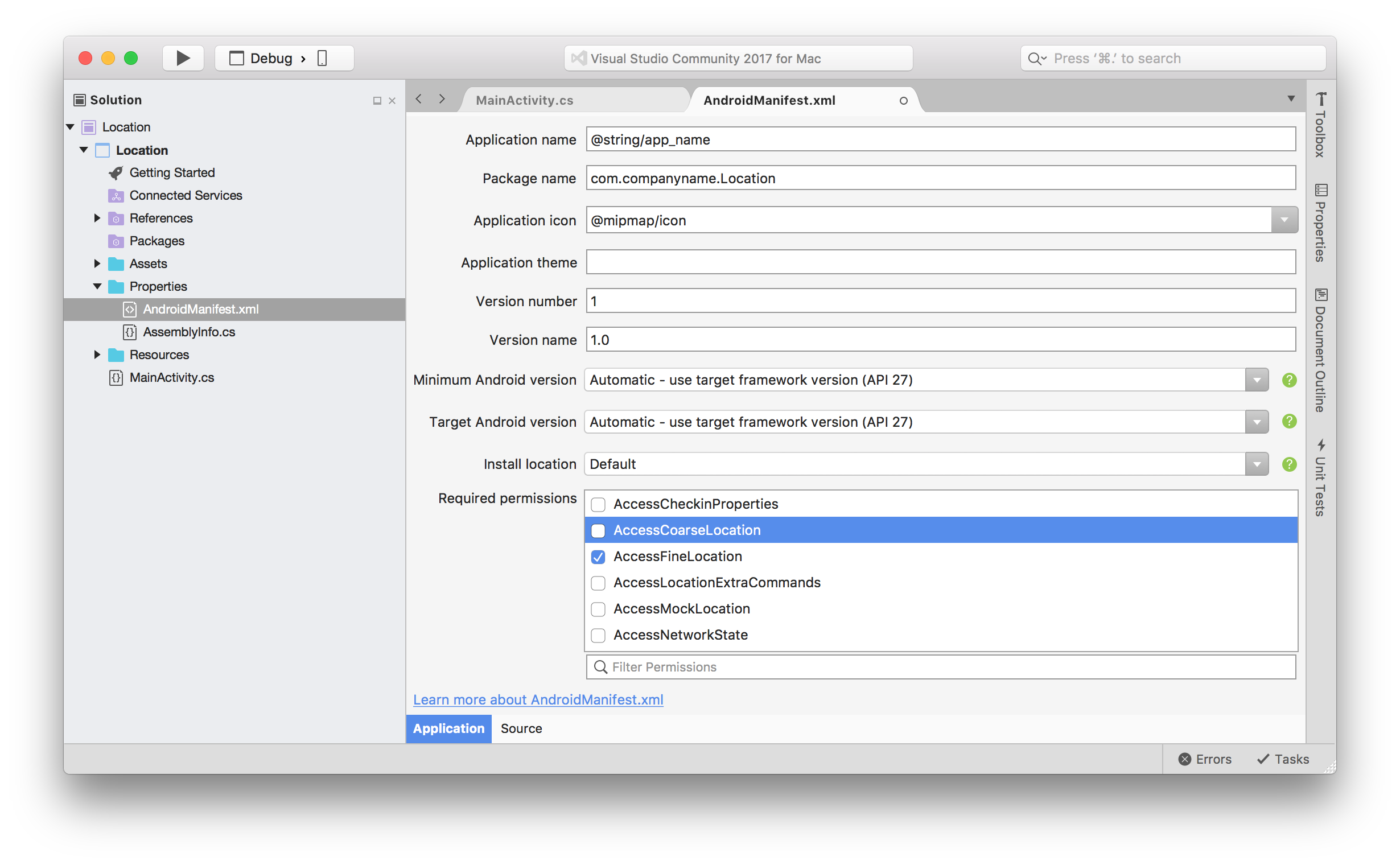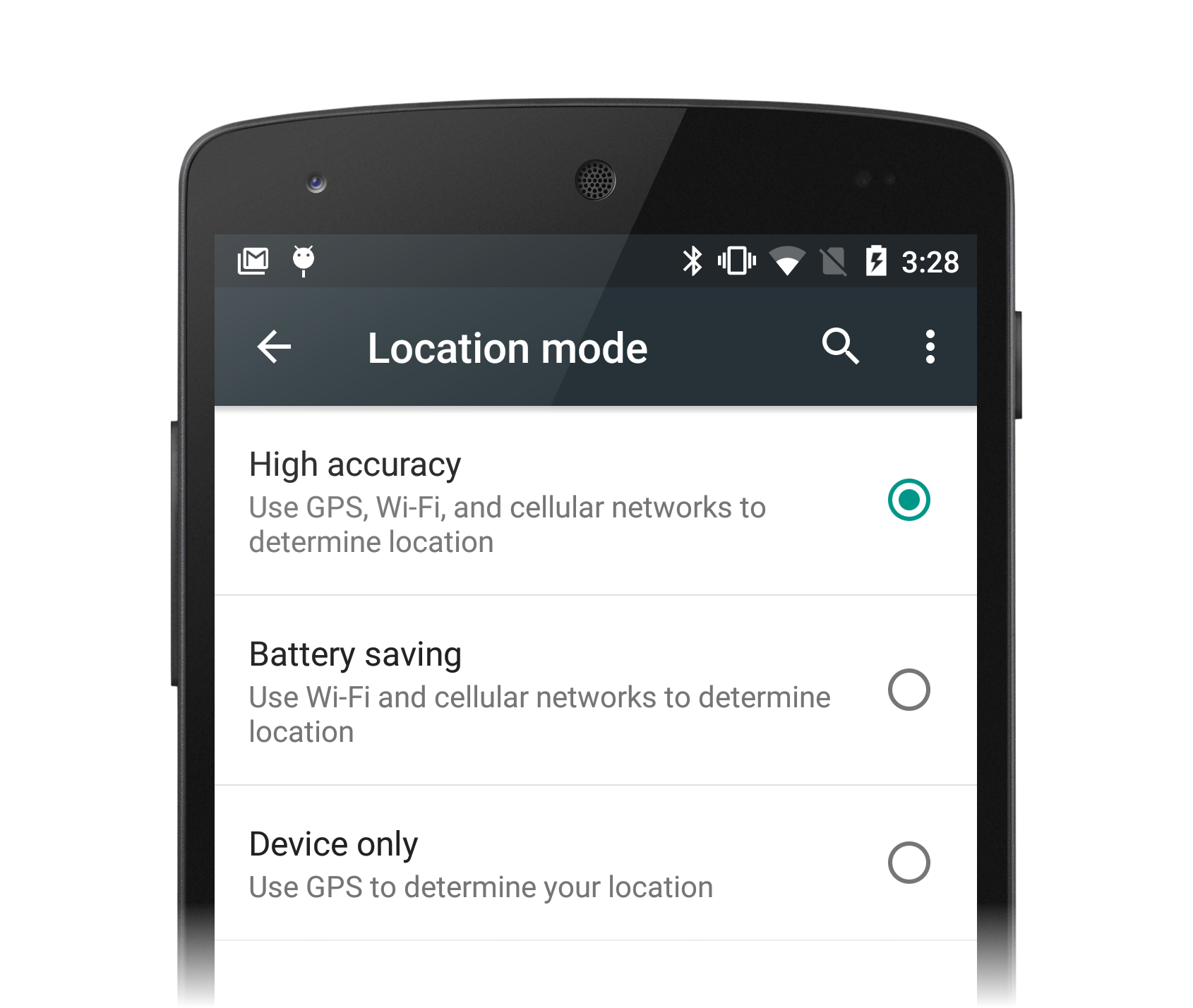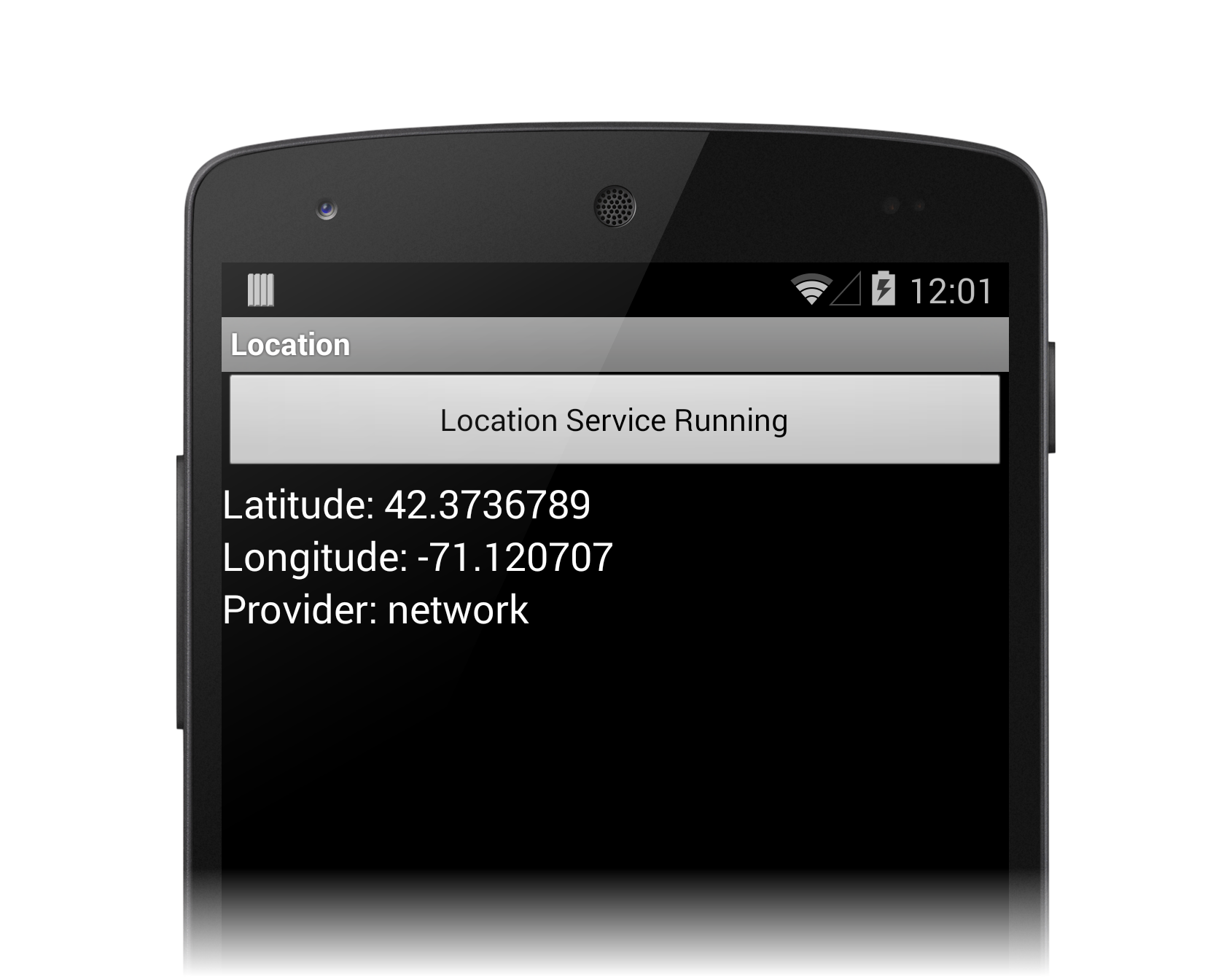Location services on Android
This guide introduces location-awareness in Android applications and illustrates how to get the user's location using the Android Location Service API, as well as the fused location provider available with the Google Location Services API.
Android provides access to various location technologies such as cell tower location, Wi-Fi, and GPS. The details of each location technology are abstracted through location providers, allowing applications to obtain locations in the same way regardless of the provider used. This guide introduces the fused location provider, a part of the Google Play Services, which intelligently determines the best way to obtain the location of the devices based on what providers are available and how the device is being used. Android Location Service API and shows how to communicate with the system location Service using a LocationManager. The second part of the guide explores the Android Location Services API using the LocationManager.
As a general rule of thumb, applications should prefer to use the fused location provider, falling back the older Android Location Service API only when necessary.
Location fundamentals
In Android, no matter what API you choose for working with location data, several concepts remain the same. This section introduces Location Providers and location-related permissions.
Location providers
Several technologies are used internally to pinpoint the user's location. The hardware used depends on the type of location provider selected for the job of collecting data. Android uses three location providers:
GPS Provider – GPS gives the most accurate location, uses the most power, and works best outdoors. This provider uses a combination of GPS and assisted GPS (aGPS), which returns GPS data collected by cellular towers.
Network Provider – Provides a combination of WiFi and Cellular data, including aGPS data collected by cell towers. It uses less power than the GPS Provider, but returns location data of varying accuracy.
Passive Provider – A "piggyback" option using providers requested by other applications or Services to generate location data in an application. This is a less reliable but power-saving option ideal for applications that don't require constant location updates to work.
Location providers are not always available. For example, we might want
to use GPS for our application, but GPS might be turned off in
Settings, or the device might not have GPS at all. If a specific
provider is not available, choosing that provider might return null.
Location permissions
A location-aware application needs access a device's hardware sensors to receive GPS, Wi-Fi, and cellular data. Access is controlled through appropriate permissions in the application's Android Manifest. There are two permissions available – depending on your application's requirements and your choice of API, you will want to allow one:
ACCESS_FINE_LOCATION– Allows an application access to GPS. Required for the GPS Provider and Passive Provider options (Passive Provider needs permission to access GPS data collected by another application or Service). Optional permission for the Network Provider.ACCESS_COARSE_LOCATION– Allows an application access to Cellular and Wi-Fi location. Required for Network Provider ifACCESS_FINE_LOCATIONis not set.
For apps that target API version 21 (Android 5.0 Lollipop) or higher,
you can enable ACCESS_FINE_LOCATION and still run on devices that do
not have GPS hardware. If your app requires GPS hardware, you should
explicitly add an android.hardware.location.gps uses-feature
element to the Android Manifest. For more information, see the Android
uses-feature
element reference.
To set the permissions, expand the Properties folder in the Solution Pad and double-click AndroidManifest.xml. The permissions will be listed under Required Permissions:
Setting either of these permissions tells Android that your application needs permission from the user in order to access to the location providers. Devices that run API level 22 (Android 5.1) or lower will ask the user to grant these permissions each time the app is installed. On devices running API level 23 (Android 6.0) or higher, the app should perform a run-time permission check before making a request of the location provider.
Note
Note: Setting ACCESS_FINE_LOCATION implies access to both coarse and
fine location data. You should never have to set both permissions, only
the minimal permission your app requires to work.
This snippet is an example of how to check that an app has permission for the ACCESS_FINE_LOCATION permission:
if (ContextCompat.CheckSelfPermission(this, Manifest.Permission.AccessFineLocation) == Permission.Granted)
{
StartRequestingLocationUpdates();
isRequestingLocationUpdates = true;
}
else
{
// The app does not have permission ACCESS_FINE_LOCATION
}
Apps must be tolerant of the scenario where the user will not grant permission (or has revoked the permission) and have a way to gracefully deal with that situation. Please see the Permissions guide for more details on implementing run-time permission checks in Xamarin.Android.
Using the fused location provider
The fused location provider is the preferred way for Android applications to receive location updates from the device because it will efficiently select the location provider during run time to provide the best location information in a battery-efficient fashion. For example, a user walking around outdoors gets the best location reading with GPS. If the user then walks indoors, where GPS works poorly (if at all), the fused location provider may automatically switch to WiFi, which works better indoors.
The fused location provider API provides a variety of other tools to
empower location-aware applications, including geofencing and activity
monitoring. In this section, we are going to focus on the basics of
setting up the LocationClient, establishing providers, and getting
the user's location.
The fused location provider is part of Google Play Services. The Google Play Services package must be installed and configured properly in the application for the fused location provider API to work, and the device must have the Google Play Services APK installed.
Before a Xamarin.Android application can use the fused location
provider, it must add the Xamarin.GooglePlayServices.Location package
to the project. In addition, the following using statements should be
added to any source files that reference the classes described below:
using Android.Gms.Common;
using Android.Gms.Location;
Checking if Google Play Services is installed
A Xamarin.Android will crash if it tries to use the fused location provider when Google Play Services is not installed (or out of date) then a runtime exception would occur. If Google Play Services is not installed, then the application should fall back to the Android Location Service discussed above. If Google Play Services is out of date, then the app could display a message to the user asking them to update the installed version of Google Play Services.
This snippet is an example of how an Android Activity can programmatically check if Google Play Services is installed:
bool IsGooglePlayServicesInstalled()
{
var queryResult = GoogleApiAvailability.Instance.IsGooglePlayServicesAvailable(this);
if (queryResult == ConnectionResult.Success)
{
Log.Info("MainActivity", "Google Play Services is installed on this device.");
return true;
}
if (GoogleApiAvailability.Instance.IsUserResolvableError(queryResult))
{
// Check if there is a way the user can resolve the issue
var errorString = GoogleApiAvailability.Instance.GetErrorString(queryResult);
Log.Error("MainActivity", "There is a problem with Google Play Services on this device: {0} - {1}",
queryResult, errorString);
// Alternately, display the error to the user.
}
return false;
}
FusedLocationProviderClient
To interact with the fused location provider, a Xamarin.Android application must have an instance of the FusedLocationProviderClient. This class exposes the necessary methods to subscribe to location updates and to retrieve the last known location of the device.
The OnCreate method of an Activity is a suitable place to get a reference to the FusedLocationProviderClient, as demonstrated in the following code snippet:
public class MainActivity: AppCompatActivity
{
FusedLocationProviderClient fusedLocationProviderClient;
protected override void OnCreate(Bundle bundle)
{
fusedLocationProviderClient = LocationServices.GetFusedLocationProviderClient(this);
}
}
Getting the last known location
The FusedLocationProviderClient.GetLastLocationAsync() method provides a simple, non-blocking way for a Xamarin.Android application to quickly obtain the last known location of the device with minimal coding overhead.
This snippet shows how to use the GetLastLocationAsync method to retrieve the location of the device:
async Task GetLastLocationFromDevice()
{
// This method assumes that the necessary run-time permission checks have succeeded.
getLastLocationButton.SetText(Resource.String.getting_last_location);
Android.Locations.Location location = await fusedLocationProviderClient.GetLastLocationAsync();
if (location == null)
{
// Seldom happens, but should code that handles this scenario
}
else
{
// Do something with the location
Log.Debug("Sample", "The latitude is " + location.Latitude);
}
}
Subscribing to location updates
A Xamarin.Android application can also subscribe to location updates from the fused location provider using the FusedLocationProviderClient.RequestLocationUpdatesAsync method, as shown in this code snippet:
await fusedLocationProviderClient.RequestLocationUpdatesAsync(locationRequest, locationCallback);
This method takes two parameters:
Android.Gms.Location.LocationRequest– ALocationRequestobject is how a Xamarin.Android application passes the parameters on how the fused location provider should work. TheLocationRequestholds information such as how frequent requests should be made or how important an accurate location update should be. For example, an important location request will cause the device to use the GPS, and consequently more power, when determining the location. This code snippet shows how to create aLocationRequestfor a location with high accuracy, checking approximately every five minutes for a location update (but not sooner than two minutes between requests). The fused location provider will use aLocationRequestas guidance for which location provider to use when trying to determine the device location:LocationRequest locationRequest = new LocationRequest() .SetPriority(LocationRequest.PriorityHighAccuracy) .SetInterval(60 * 1000 * 5) .SetFastestInterval(60 * 1000 * 2);Android.Gms.Location.LocationCallback– In order to receive location updates, a Xamarin.Android application must subclass theLocationProviderabstract class. This class exposed two methods which maybe invoked by the fused location provider to update the app with location information. This will be discussed in more detail below.
To notify a Xamarin.Android application of a location update, the fused
location provider will invoke the
LocationCallBack.OnLocationResult(LocationResult result). The
Android.Gms.Location.LocationResult parameter will contain the update
location information.
When the fused location provider detects a change in the availability
of location data, it will call the
LocationProvider.OnLocationAvailability(LocationAvailability locationAvailability) method. If the
LocationAvailability.IsLocationAvailable property returns true,
then it can be assumed that the device location results reported by
OnLocationResult are as accurate and as up to date as required by the
LocationRequest. If IsLocationAvailable is false, then no location
results will be return by OnLocationResult.
This code snippet is a sample implementation of the LocationCallback object:
public class FusedLocationProviderCallback : LocationCallback
{
readonly MainActivity activity;
public FusedLocationProviderCallback(MainActivity activity)
{
this.activity = activity;
}
public override void OnLocationAvailability(LocationAvailability locationAvailability)
{
Log.Debug("FusedLocationProviderSample", "IsLocationAvailable: {0}",locationAvailability.IsLocationAvailable);
}
public override void OnLocationResult(LocationResult result)
{
if (result.Locations.Any())
{
var location = result.Locations.First();
Log.Debug("Sample", "The latitude is :" + location.Latitude);
}
else
{
// No locations to work with.
}
}
}
Using the Android Location Service API
The Android Location Service is an older API for using location
information on Android. Location data is collected by hardware sensors
and collected by a system service, which is accessed in the application
with a LocationManager class and an ILocationListener.
The Location Service is best suited for applications that must run on devices that do not have Google Play Services installed.
The Location Service is a special type of
Service
managed by the System. A System Service interacts with the device
hardware and is always running. To tap into location updates in our
application, we will subscribe to location updates from the system
Location Service using a LocationManager and a
RequestLocationUpdates call.
To obtain the user's location using Android Location Service involves several steps:
- Get a reference to the
LocationManagerservice. - Implement the
ILocationListenerinterface and handle events when the location changes. - Use the
LocationManagerto request location updates for a specified provider. TheILocationListenerfrom the previous step will be used to receive callbacks from theLocationManager. - Stop location updates when the application it is no longer appropriate to receive updates.
Location Manager
We can access the system location service with an instance of the
LocationManager class. LocationManager is a special class that lets
us interact with the system location Service and call methods on it. An
application can get a reference to the LocationManager by calling
GetSystemService and passing in a Service type, as shown below:
LocationManager locationManager = (LocationManager) GetSystemService(Context.LocationService);
OnCreate is a good place to get a reference to the LocationManager.
It's a good idea to keep the LocationManager as a class variable, so
that we can call it at various points in the Activity lifecycle.
Request location updates from the LocationManager
Once the application has a reference to the LocationManager, it needs to tell the LocationManager what type of location information that are required, and how often that information is to be updated. Do this by calling RequestLocationUpdates on the LocationManager object, and passing in some criteria for updates and a callback that will receive the location updates. This callback is a type that must implement the ILocationListener interface (described in more detail later in this guide).
The RequestLocationUpdates method tells the system location Service that your application would like to start receiving location updates. This method allows you to specify the provider, as well as time and distance thresholds to control update frequency. For example, the method below requests location updates from the GPS location provider every 2000 milliseconds, and only when the location changes more than 1 metre:
// For this example, this method is part of a class that implements ILocationListener, described below
locationManager.RequestLocationUpdates(LocationManager.GpsProvider, 2000, 1, this);
An application should request location updates only as often as required for the application to perform well. This preserves battery life and creates a better experience for the user.
Responding to updates from the LocationManager
Once an application has requested updates from the LocationManager, it can receive information from the Service by implementing the ILocationListener interface. This interface provides four methods for listening to the location Service and the location provider, OnLocationChanged. The System will call OnLocationChanged when the user's location changes enough to qualify as a location change according to the Criteria set when requesting location updates.
The following code shows the methods in the ILocationListener interface:
public class MainActivity : AppCompatActivity, ILocationListener
{
TextView latitude;
TextView longitude;
public void OnLocationChanged (Location location)
{
// called when the location has been updated.
}
public OnProviderDisabled(string locationProvider)
{
// called when the user disables the provider
}
public OnProviderEnabled(string locationProvider)
{
// called when the user enables the provider
}
public OnStatusChanged(string locationProvider, Availability status, Bundle extras)
{
// called when the status of the provider changes (there are a variety of reasons for this)
}
}
Unsubscribing to LocationManager updates
In order to conserve system resources, an application should unsubscribe to location updates as soon as possible. The RemoveUpdates method tells the LocationManager to stop sending updates to our application. As an example, an Activity may call RemoveUpdates in the OnPause method so that we are able to conserve power if an application doesn't need location updates while its Activity is not on the screen:
protected override void OnPause ()
{
base.OnPause ();
locationManager.RemoveUpdates (this);
}
If your application needs to get location updates while in the background, you'll want to create a custom Service that subscribes to the system Location Service. Refer to the Backgrounding with Android Services guide for more information.
Determining the best location provider for the LocationManager
The application above sets GPS as the location provider. However, GPS may not be available in all cases, such as if the device is indoors or does not have a GPS receiver. If this is the case, the result is a null return for the Provider.
To get your app to work when GPS is not available, you use the GetBestProvider method to ask for the best available (device-supported and user-enabled) location provider at application launch. Instead of passing in a specific provider, you can tell GetBestProvider the requirements for the provider - such as accuracy and power - with a Criteria object. GetBestProvider returns the best provider for the given Criteria.
The following code shows how to get the best available provider and use it when requesting location updates:
Criteria locationCriteria = new Criteria();
locationCriteria.Accuracy = Accuracy.Coarse;
locationCriteria.PowerRequirement = Power.Medium;
locationProvider = locationManager.GetBestProvider(locationCriteria, true);
if(locationProvider != null)
{
locationManager.RequestLocationUpdates (locationProvider, 2000, 1, this);
}
else
{
Log.Info(tag, "No location providers available");
}
Note
If the user has disabled all location providers,
GetBestProvider will return null. To see how this code works on a
real device, be sure to enable GPS, Wi-Fi, and cellular networks under
Google Settings > Location > Mode as shown in this screenshot:
The screenshot below demonstrates the location application running using GetBestProvider:
Keep in mind that GetBestProvider does not change the provider dynamically. Rather, it determines the best available provider once during the Activity lifecycle. If the provider status changes after it has been set, the application will require additional code in the ILocationListener methods – OnProviderEnabled, OnProviderDisabled, and OnStatusChanged – to handle every possibility related to the provider switch.
Summary
This guide covered obtaining the user's location using both the Android Location Service and the fused location provider from Google Location Services API.


